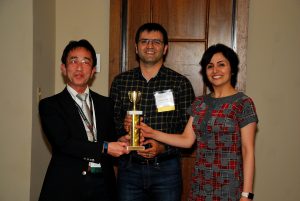Technical Program Co-Chair, Hidenori Nakazato, presenting Best Paper Award to Vahid Esmaeelzadeh and Elahe Hosseini
Best Paper! – Delay and Backlog Analysis of a Cognitive Radio Node: A Queue with Primary User-Based Breakdowns by Vahid Esmaeelzadeh, Elahe S. Hosseini and Bob Roohparvar
Abstract – Primary users’ activity in cognitive radio networks (CRNs) affects the performance of a cognitive radio (CR) node in the terms of delay and backlog. The delay overhead of CR nodes has great impact on the performance and delay-based quality of service (QoS) of network protocols in CRNs. In this study, we propose two queuing systems of M/M/1 and M/M/C with PU-based breakdowns for a single-channel and multichannel CR node, respectively. The mean delay and backlog of the CR node are analyzed in the queuing systems with finite and infinite queue capacities as a function of the mean arrival, the service rates of the CR node, the mean entrance and departure rates of primary user, channel number and queue capacity. Finally, the proposed models are verified through several simulation experiments and some performance analysis are presented
Comparative Performance of Green Pipe, Green Hose and Green-Hose-Rectangle Models in Power Efficient Network by Bimal Das, Eiji Oki and Masakazu Muramatsu
Abstract – In this paper, a green and robust optimization model is proposed to the problem of minimizing network power consumption which can deal with uncertainty in traffic demands. The green pipe model achieves the first position in terms of minimizing network power consumption if we know the exact traffic demand. However, in reality, traffic demands fluctuate due to various situation. The hose model, which is formulated from the total outgoing/incoming amount of traffic from/to each node can allows errors in the traffic demands but its power consumption is higher than that of the green pipe model. Our proposed scheme is based on the green pipe model. For robust optimization, we use an uncertainty set which is the intersection of the hose and rectangle uncertainty set. The rectangle uncertainty set narrows the range of traffic conditions defined by the hose model by adding the upper and lower bounds for each source-destination pair in the network. In the worst case of traffic flow, we consider a subproblem and formulate the green hose-rectangle model (green HR) in the form of mixed-integer linear programming (MILP). Numerical results demonstrate that the problems obtained by the proposed green HR model can be solved by optimization software and reduce the network power consumption compare to the green hose model.
Gold Code-Phase-Shift Keying: A Power and Bandwidth Efficient Communication Scheme for Smart Buildings by Stephen Killough, Mohammed M. Olama and Teja Kuruganti
Abstract – Advanced communications, sensors and controls play an important role in reducing the energy consumption of smart buildings. Wireless sensors have been recently deployed in buildings to provide monitoring and control of several devices such as heating, ventilation, and air-conditioning (HVAC) and lighting systems. In this paper, we present a low-power bandwidth-efficient communication scheme that can be driven by energy harvesting in self-powered wireless sensors. The proposed communication scheme is based on Gold code-phase-shift keying (CPSK) spread-spectrum signaling that improves both transmitter range and power consumption. We present our efforts toward exploring the design, implementation, and performance evaluation of a hardware prototypic Gold CPSK spread-spectrum radio transceiver. Experimental testing in addition to end-to-end system-level simulation-based studies are conducted to evaluate the performance of the Gold CPSK transceiver in terms of receiver sensitivity, coverage range, average probability of bit-error over standard Gaussian and Rayleigh fading-type channels, and multiple access capabilities. The specific engineering tradeoffs are also discussed.
An Intrusion Detection System for Detecting Compromised Gateways in Clustered IoT Networks by Venkata Abhishek Nalam, Teng Joon Lim, Biplab Sikdar and Anshoo Tandon
Abstract – It is well known that clustering IoT devices will help to alleviate the network scalability problem in IoT networks. However, clustering also provides an opportunity for an adversary to compromise a set of nodes by simply compromising their gateway. In such scenarios, one of the strategies available to an adversary to degrade the performance of a network is by corrupting the packets to be forwarded by the gateway. In this paper, a centralized detection system for detecting the presence of such a malicious gateway is proposed. The proposed system uses the packet drop probability as a means to monitor the gateways. An algorithm is presented to design the key parameters of the proposed system. Results are presented to verify the detection statistics and show the effectiveness of the system.
CCAR: Caching and Content-Aware Routing for Content Oriented Networking by Yusaku Hayamizu, Kouji Hirata and Miki Yamamoto
Abstract – ICN (Information-Centric Networking) has been proposed for efficient content distribution to deal with rapid increase in the Internet traffic. This paper proposes a caching and content-aware routing method named CCAR. CCAR operates based on the ICN concept that users can obtain contents from anywhere in networks. CCAR is formulated as an optimization problem to coordinately perform content placement to caches and content download based on content-oriented traffic engineering. In this paper, after we formulate CCAR, we decompose the problem to a content placement sub-problem and a traffic engineering sub-problem. In the content placement sub-problem, contents are placed at routers by a local search algorithm. The traffic engineering sub-problem calculates routes according to the content placement. Our numerical results show that CCAR efficiently reduces the maximum link utilization.



